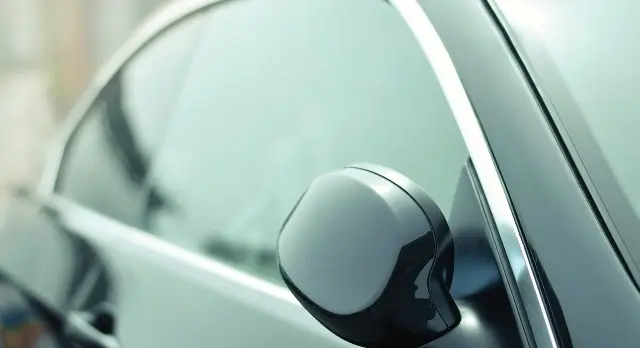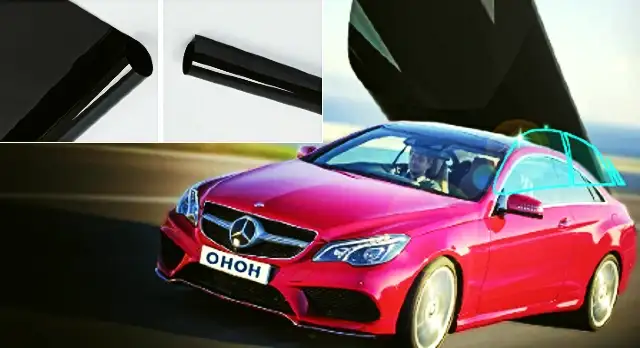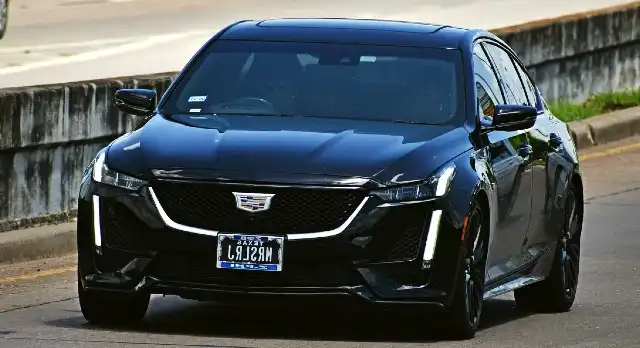When it comes to window tinting, there’s a new player on the block that’s revolutionizing the game: ceramic window tint. This cutting-edge technology has taken the window film industry by storm, offering unmatched performance, exceptional clarity, and a host of benefits that go beyond what traditional window films can provide.
Ceramic window tint utilizes state-of-the-art ceramic nanoparticles that work together to create a film with superior heat rejection, advanced UV protection, and remarkable optical clarity. This groundbreaking solution is metal-free, making it the perfect choice for vehicles equipped with modern electronics that can be affected by traditional metallic films.
One of the standout features of ceramic window tint is its ability to combat heat effectively. By incorporating advanced ceramic nanoparticles into the film, it acts as an impenetrable barrier against solar heat, keeping your vehicle or building cooler and more comfortable even on the hottest days. Say goodbye to the relentless sunrays that turn your car into an oven or transform your home or office into an unbearable sauna.
Whether you’re a car enthusiast seeking a cooler and more stylish ride, a homeowner aiming to protect your interior and boost energy efficiency, or a business owner looking to create a more comfortable and professional environment, ceramic window tint is the ultimate solution. Experience the power of advanced technology, uncompromising performance, and unmatched benefits with ceramic window tint a game-changer in the world of window film.
What is Ceramic Window Tint?

Ceramic window tint is an innovative and advanced window film technology that utilizes ceramic nanoparticles to provide superior performance in heat rejection, UV protection, optical clarity, and durability. Unlike traditional window films that often contain metals, such as aluminum, ceramic window tint is metal-free, making it compatible with modern electronics found in vehicles and buildings. This state-of-the-art solution offers a range of benefits and is widely used in automotive, residential, and commercial applications.
How is Ceramic Tint for Windows Made?

The manufacturing process of ceramic window tint involves the integration of ceramic nanoparticles into a film structure.
A. Overview of the Manufacturing Process
The production of ceramic window tint involves a carefully controlled process to ensure the integration of ceramic nanoparticles into a film structure. Here is an overview of the general steps involved in manufacturing ceramic tint for windows:
- Nanoparticle Preparation: High-quality ceramic nanoparticles, such as titanium nitride or aluminum oxide, are selected based on their desired properties. These nanoparticles are typically engineered to have specific sizes and shapes to optimize performance.
- Suspension Preparation: The ceramic nanoparticles are dispersed in a liquid solution to create a homogeneous suspension. This step ensures an even distribution of the nanoparticles within the film.
- Film Production: The suspension is then applied to a high-quality polyester film using various techniques such as spraying, coating, or vacuum deposition. The film acts as a carrier for the ceramic nanoparticles.
- Drying and Curing: The applied suspension undergoes a drying process to remove the liquid solvent, leaving a thin layer of ceramic nanoparticles on the film. Afterward, the film is cured under controlled conditions, allowing the nanoparticles to bond to the film surface and form a stable structure.
- Lamination and Adhesive Application: Depending on the specific requirements, the ceramic film may undergo lamination with additional layers to enhance durability, performance, or aesthetic properties. An adhesive layer is also added to facilitate installation and ensure a secure bond to the window.
B. Materials Used in Ceramic Window Tint Production
Ceramic Nanoparticles: The primary material used in ceramic window tint is high-quality ceramic nanoparticles. These nanoparticles are typically made of non-metallic compounds like titanium nitride or aluminum oxide. They are chosen for their excellent heat-rejecting, UV-blocking, and optical properties.
Polyester Film: The base material for ceramic window tint is a high-grade polyester film. It provides structural integrity, flexibility, and transparency to the tint.
Liquid Solvent: A liquid solvent is used to create a suspension of ceramic nanoparticles. The solvent allows for the uniform dispersion of nanoparticles and acts as a carrier during the application process.
Lamination Layers: Additional layers may be added during the lamination process to enhance the film’s properties. These layers could include scratch-resistant coatings, anti-glare coatings, or color-enhancing layers.
C. Explanation of the Production Techniques Involved
Dispersion Techniques: To create a homogeneous suspension, ceramic nanoparticles are dispersed in a liquid solvent. Techniques such as ultrasonication or high-shear mixing are employed to ensure that the nanoparticles are evenly distributed throughout the solution.
Application Techniques: The suspension containing the ceramic nanoparticles is applied to the polyester film using various methods. This can include spraying the suspension onto the film surface, coating it through a roll-to-roll process, or employing vacuum deposition techniques for precise control of nanoparticle deposition.
Drying and Curing: After the suspension is applied, the film undergoes a drying process to remove the liquid solvent. This can be achieved through air drying or by using controlled heat sources. Subsequently, the film is cured under specific conditions, such as elevated temperature or exposure to UV light, to ensure the nanoparticles bond to the film surface and create a stable structure.
Lamination and Adhesive Application: Depending on the desired properties and performance requirements, the ceramic film may undergo lamination with additional layers. These layers can be applied using techniques like roll lamination or vacuum lamination. An adhesive layer is also applied to the film, allowing for easy installation and providing a secure bond to the window surface.
Through a combination of precise manufacturing techniques, careful selection of materials, and controlled processes, ceramic window tint is produced to deliver exceptional performance in terms of heat rejection, UV protection, optical clarity, and durability. The result is a high-quality window film that enhances comfort, protects interiors, and improves energy efficiency in various applications.
What are the Benefits of a Ceramic Window tint?

Ceramic window tint offers a range of significant benefits that make it a superior choice for window film applications. From heat rejection to UV protection and more, the advantages of ceramic window tint are numerous. Here, we will explore the key benefits in detail.
1. Superior Heat Rejection:
Ceramic window tint utilizes advanced ceramic nanoparticles that effectively block and reflect solar heat. By significantly reducing the amount of heat entering through windows, ceramic tint helps maintain a cooler and more comfortable interior environment. This is particularly beneficial in vehicles, homes, and commercial buildings, as it reduces the reliance on air conditioning systems, improves energy efficiency, and enhances overall comfort.
2. Exceptional UV Protection:
One of the standout features of ceramic window tint is its remarkable ability to block harmful ultraviolet (UV) radiation. The ceramic nanoparticles within the film act as a barrier, absorbing and scattering up to 99% of UV rays. This level of UV protection provides numerous benefits, including the safeguarding of vehicle occupants from potential health risks associated with prolonged UV exposure. Additionally, ceramic tint helps prevent the fading, discoloration, and deterioration of interior furnishings, upholstery, and flooring in homes and commercial spaces.
3. Optimal Optical Clarity:
Ceramic window tint is designed to maintain excellent optical clarity. Unlike some other types of window films that can have a reflective or hazy appearance, ceramic tint remains optically clear. This means that it allows for unobstructed views both from the inside and outside, providing drivers with excellent visibility and preserving the natural aesthetic appeal of windows. The clarity of ceramic tint ensures a seamless and visually pleasing experience without compromising privacy.
4. Enhanced Durability:
With its composition of robust ceramic nanoparticles, ceramic window tint offers exceptional durability and longevity. The film is highly resistant to fading, bubbling, and peeling, even under prolonged exposure to sunlight and harsh weather conditions. This durability ensures that the tint maintains its performance and appearance over an extended period, making it a wise long-term investment.
5. Compatibility with Electronics:
Unlike traditional window films that may contain metallic elements, ceramic window tint is metal-free. This makes it compatible with modern electronic devices, such as GPS systems, cell phones, and radios. By eliminating interference with electronic signals, ceramic tint provides peace of mind and convenience for vehicle owners and ensures optimal functionality of electronic equipment.
6. Increased Privacy:
Ceramic window tint also enhances privacy by reducing the visibility into vehicles, homes, and commercial spaces from the outside. The film effectively blocks the view while still allowing occupants to see out clearly. This added privacy not only enhances security but also creates a more comfortable and private space.
7. Energy Efficiency:
By blocking a significant amount of solar heat, ceramic window tint helps improve energy efficiency. It reduces the need for excessive air conditioning, particularly in vehicles and buildings exposed to intense sunlight. This can lead to lower energy consumption, decreased carbon footprint, and cost savings on energy bills.
How Much Does Ceramic Window Tint Cost?
When considering ceramic window tint for your vehicle or property in the United States, it’s helpful to have an idea of the typical cost range. The pricing of ceramic window tint can vary across different states and cities due to various factors. Let’s explore the most important cost considerations in detail.
1. Average Cost Range:
The cost of ceramic window tint installation in the USA typically falls within the range of $400 to $800 for a standard-sized vehicle. This cost can vary based on factors such as the size of the windows, complexity of the project, type and quality of the ceramic tint, professional installation, additional features, and geographic location.
2. Vehicle Type:
The cost of ceramic window tint installation can vary depending on the type of vehicle. Compact cars generally have fewer windows and may require less material and labor, resulting in a lower cost. On the other hand, larger vehicles, such as SUVs or vans, with more windows and complex shapes, may require more tinting material and additional labor, leading to a higher cost.
3. Residential and Commercial Applications:
For residential and commercial applications, the cost of ceramic window tint is typically based on the square footage of the windows or the overall project size. Larger windows or extensive areas will require more tinting material and labor, resulting in higher costs. Additionally, windows with multiple panes, unique shapes, or challenging installation requirements may increase the overall expense.
4. Professional Installation:
Professional installation is crucial for achieving the best results with ceramic window tint. The cost of installation can vary depending on the experience and expertise of the installer, as well as the location and complexity of the project. It is recommended to hire a reputable and experienced installer who can ensure proper application and compliance with local regulations. Some installers may provide package deals or discounts for multiple windows or projects, so it’s worth inquiring about any available promotions.
5. Additional Features and Services:
Additional features and services can impact the cost of ceramic window tint. These may include additional layers such as anti-glare coatings, scratch-resistant coatings, or color enhancements. Each added feature will increase the overall cost. Some installers may offer warranties or maintenance packages, which can add to the upfront cost but provide long-term value and peace of mind.
6. Geographic Location:
The cost of ceramic window tint can vary based on the geographic location within the USA. Factors such as the local market, competition, and cost of living can influence pricing. Major cities or regions with a higher cost of living may have higher prices compared to areas with lower overhead costs or more competition among tinting specialists. It is advisable to gather multiple quotes from different installers in your specific area to compare prices and services.
While these cost considerations provide a general guideline, it’s important to note that actual prices may vary depending on the factors mentioned above and individual installer pricing. To get an accurate cost estimate for your specific needs, it is recommended to consult with local tinting professionals who can assess your requirements, measure the windows, discuss options, and provide a customized quote.
By considering the average cost range, vehicle type, residential or commercial applications, professional installation, additional features and services, and geographic location, you can have a better understanding of the cost factors involved in installing ceramic window tint in the USA. This will help you plan your budget accordingly and make an informed decision.
How to choose the right ceramic window tint?
A. Understanding VLT Percentages and Local Regulations:
Visible Light Transmission (VLT): VLT refers to the amount of visible light that can pass through the window tint. It is measured as a percentage, where a higher percentage indicates more light transmission. Different states in the USA have regulations regarding the permissible VLT percentages for window tints on various applications, such as vehicles or buildings. It’s important to familiarize yourself with these regulations to ensure compliance.
Legal Requirements: Check the specific regulations in your state or locality to determine the permissible VLT percentages for ceramic window tinting. For example, some states may require a higher VLT percentage for the front side windows compared to the rear side windows or back window.
B. Considerations for Different Applications:
Automotive: When choosing ceramic window tint for your vehicle, consider factors such as heat reduction, UV protection, and glare reduction. Additionally, ensure that the tint complies with your state’s regulations for automotive window tints. Seek a professional installer who is experienced in automotive applications to achieve optimal results.
Residential: For residential applications, ceramic window tint can offer similar benefits, including heat reduction, UV protection, and increased privacy. Consider the specific needs of your home, such as rooms with excessive sunlight or privacy concerns, and choose the appropriate VLT percentage accordingly. Seek a reputable window tinting company that specializes in residential installations for best results.
Commercial: Commercial buildings can benefit from ceramic window tinting by reducing heat transfer, glare, and UV radiation. Additionally, consider factors like aesthetics, energy efficiency, and any specific requirements related to the building’s usage or local regulations. Consult with a professional tinting service that has experience in commercial applications to ensure compliance and desired outcomes.
C. Brands and Manufacturers Offering Ceramic Window Tint Options:
3M: 3M is a well-known brand offering a range of ceramic window tint options. Their ceramic films are designed to provide excellent heat rejection, UV protection, and durability.
LLumar: LLumar offers ceramic window tints that are known for their high-performance properties. They provide advanced heat rejection, UV protection, and glare reduction, along with fade resistance and scratch-resistant coatings.
Solar Gard: Solar Gard offers ceramic window tints that combine advanced ceramic technology with enhanced optical clarity. Their films are designed to provide exceptional heat rejection, UV protection, and glare reduction.
SunTek: SunTek manufactures ceramic window tints that offer a balance of performance and aesthetics. Their films provide heat rejection, UV protection, and glare reduction while maintaining a neutral appearance.
When considering specific brands and manufacturers, it’s important to research customer reviews, warranties offered, and the expertise of authorized dealers/installers in your area. This will help you make an informed decision and ensure the quality and reliability of the ceramic window tint you choose.
Conclusion
In conclusion, ceramic window tint is often considered a worthwhile investment due to its numerous benefits. While it may be more expensive than other types of window tinting options, the advantages it offers justify the higher cost for many individuals and businesses.
Ceramic window tint provides exceptional heat reduction, effectively blocking infrared radiation and keeping the interior of vehicles, residential spaces, or commercial buildings cooler. This not only enhances comfort but also reduces the reliance on air conditioning, leading to potential energy savings.
Additionally, ceramic tint offers superior UV protection, blocking up to 99% of harmful UV rays. This helps to protect the skin from sun damage and prevents interior fading and deterioration of surfaces like upholstery and dashboard components.
